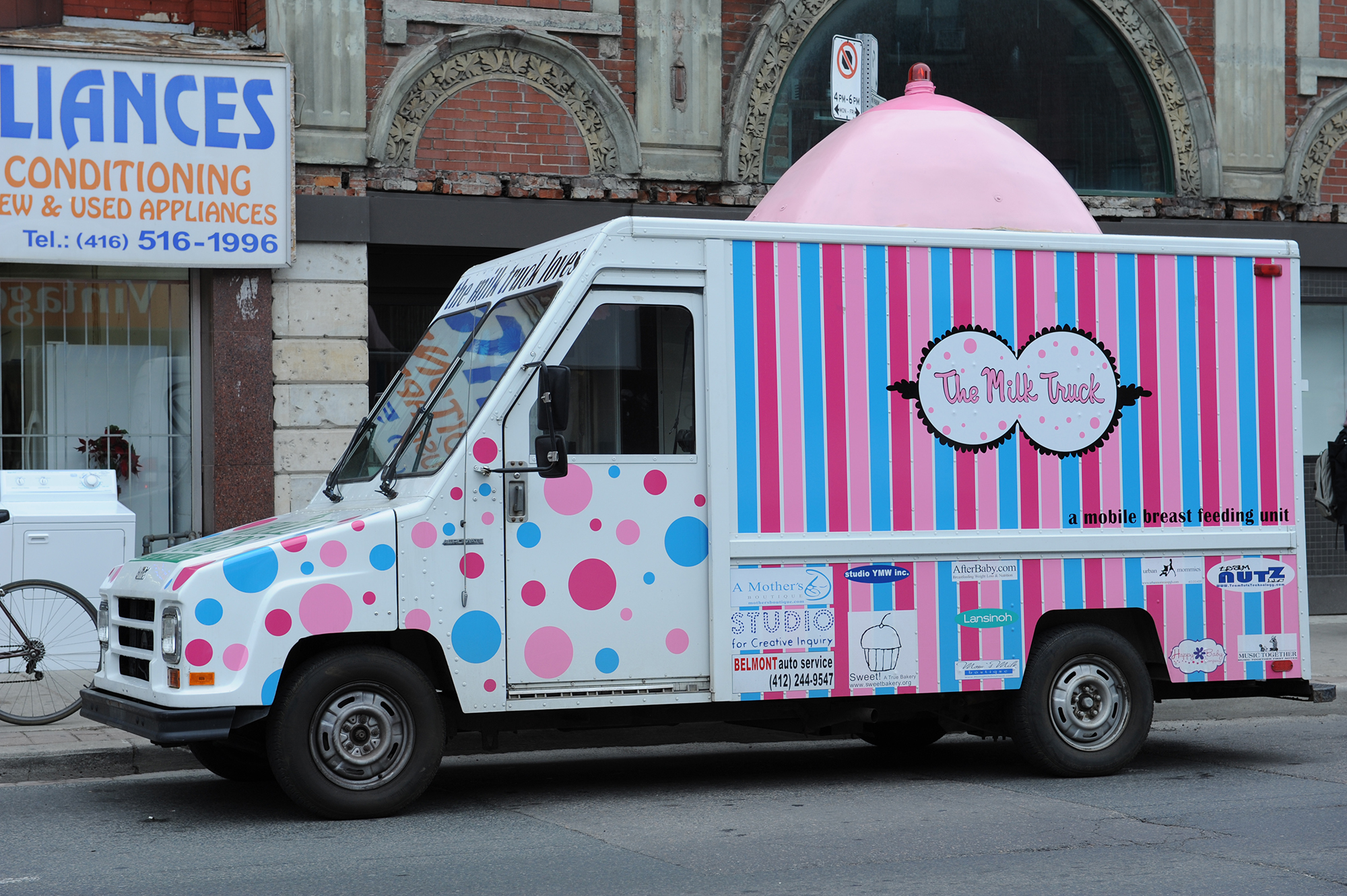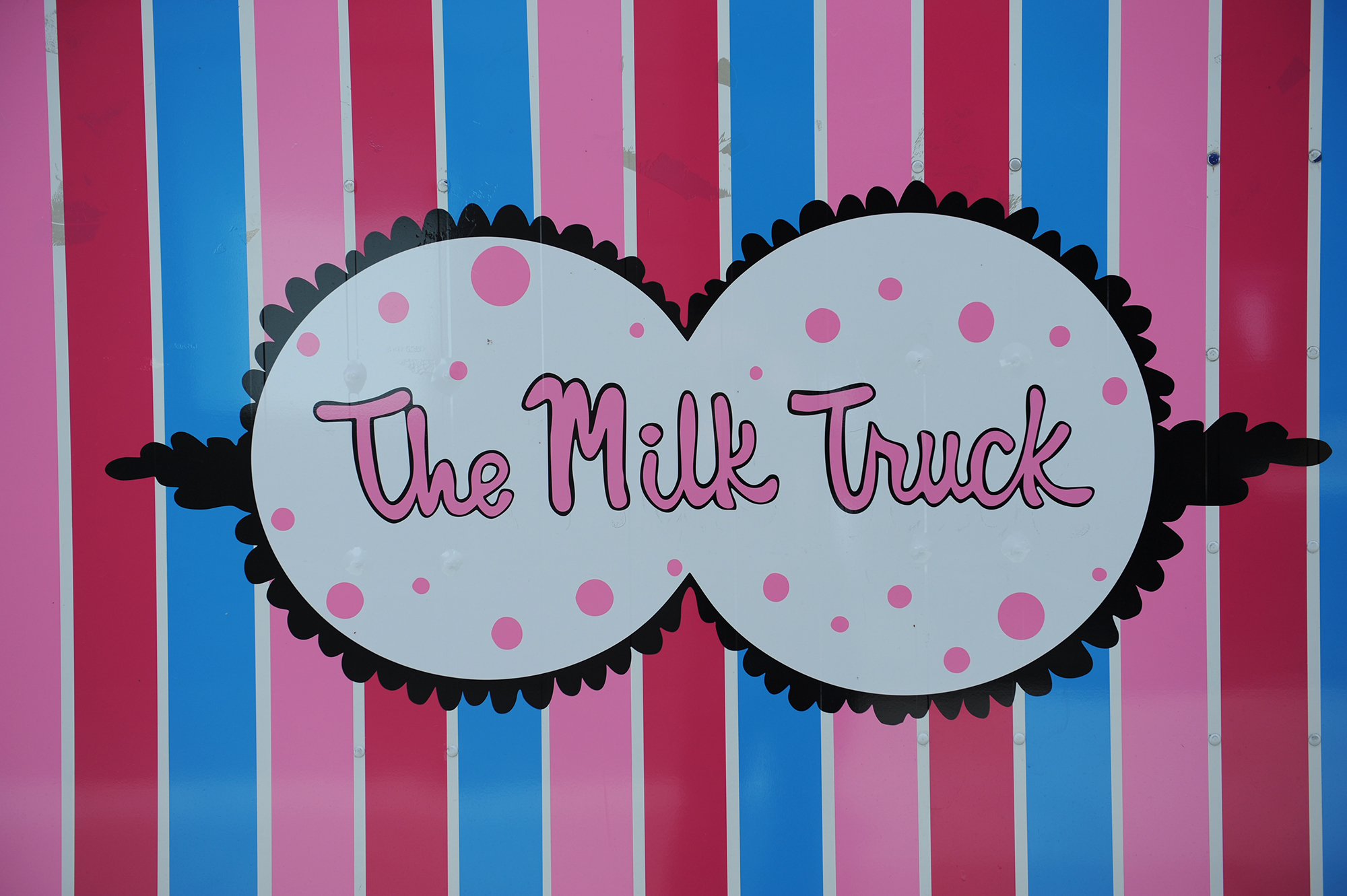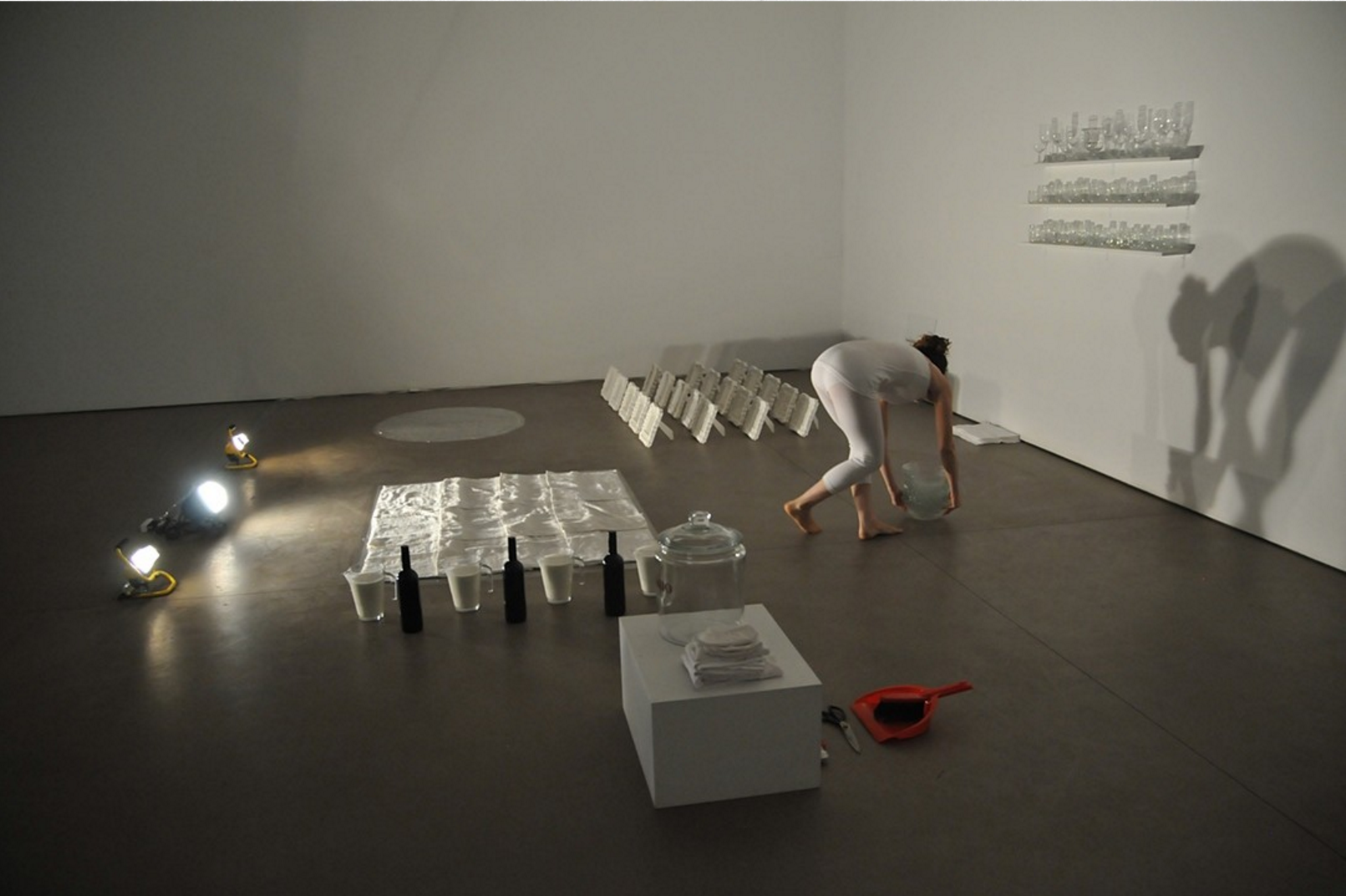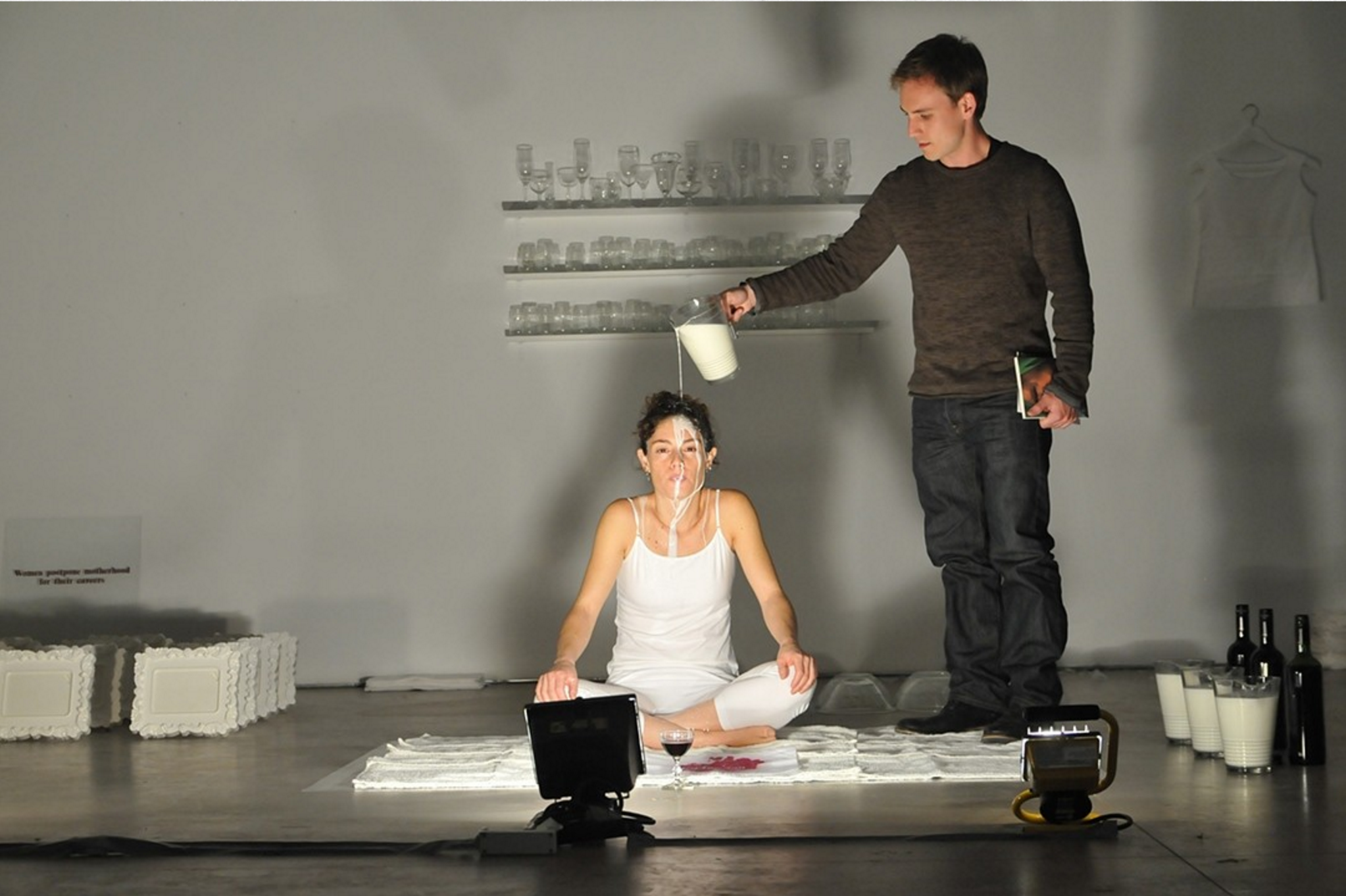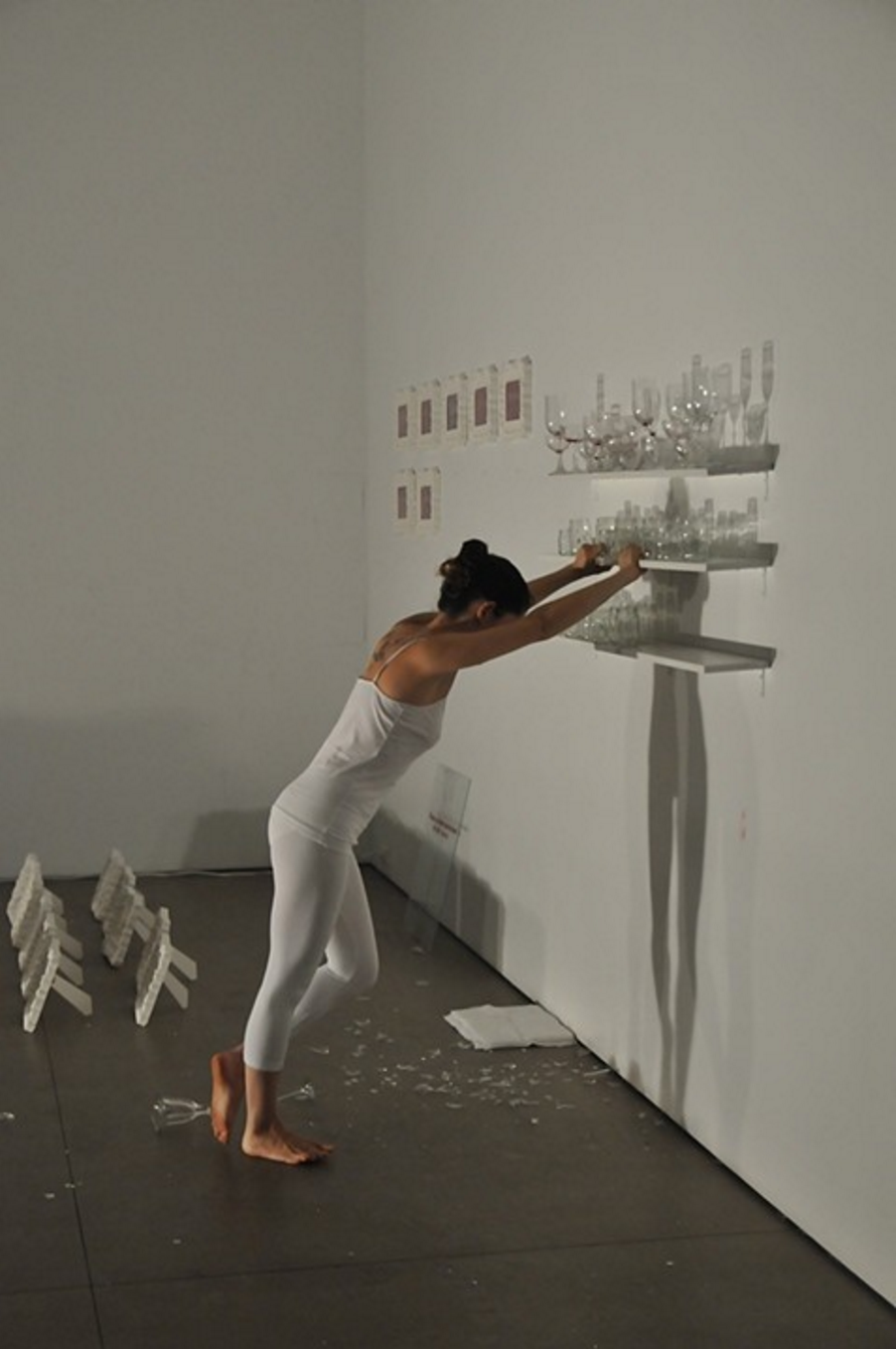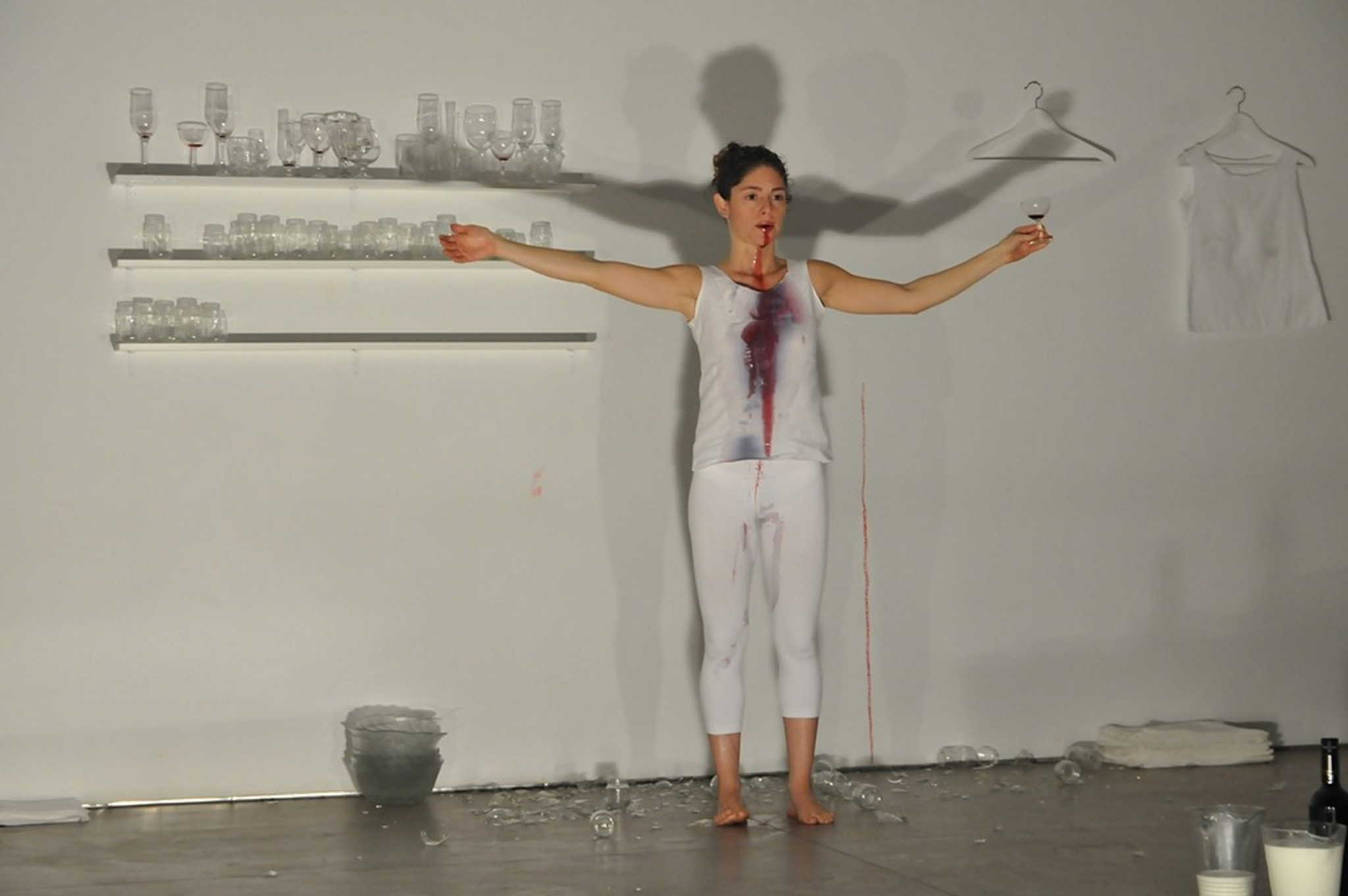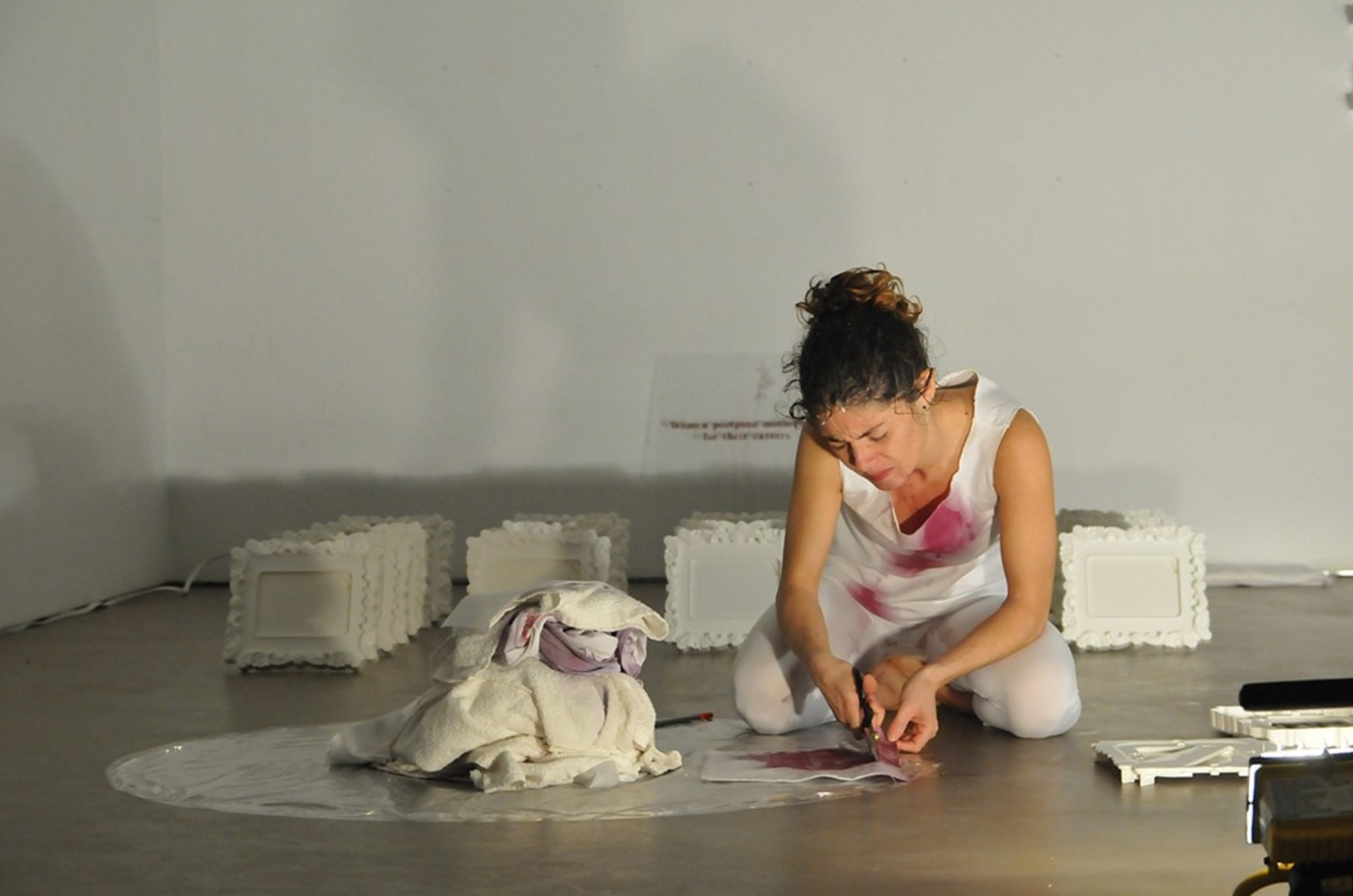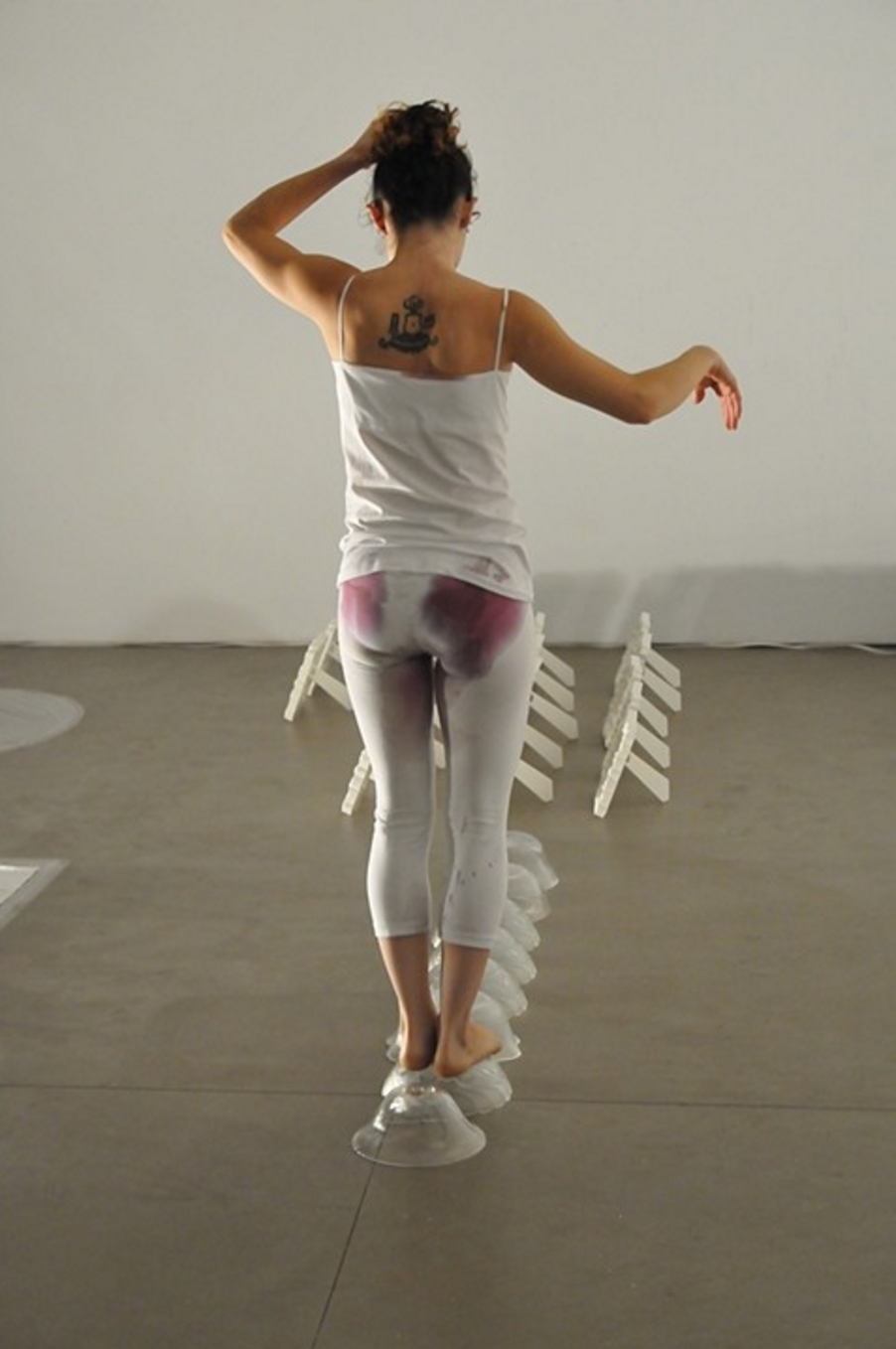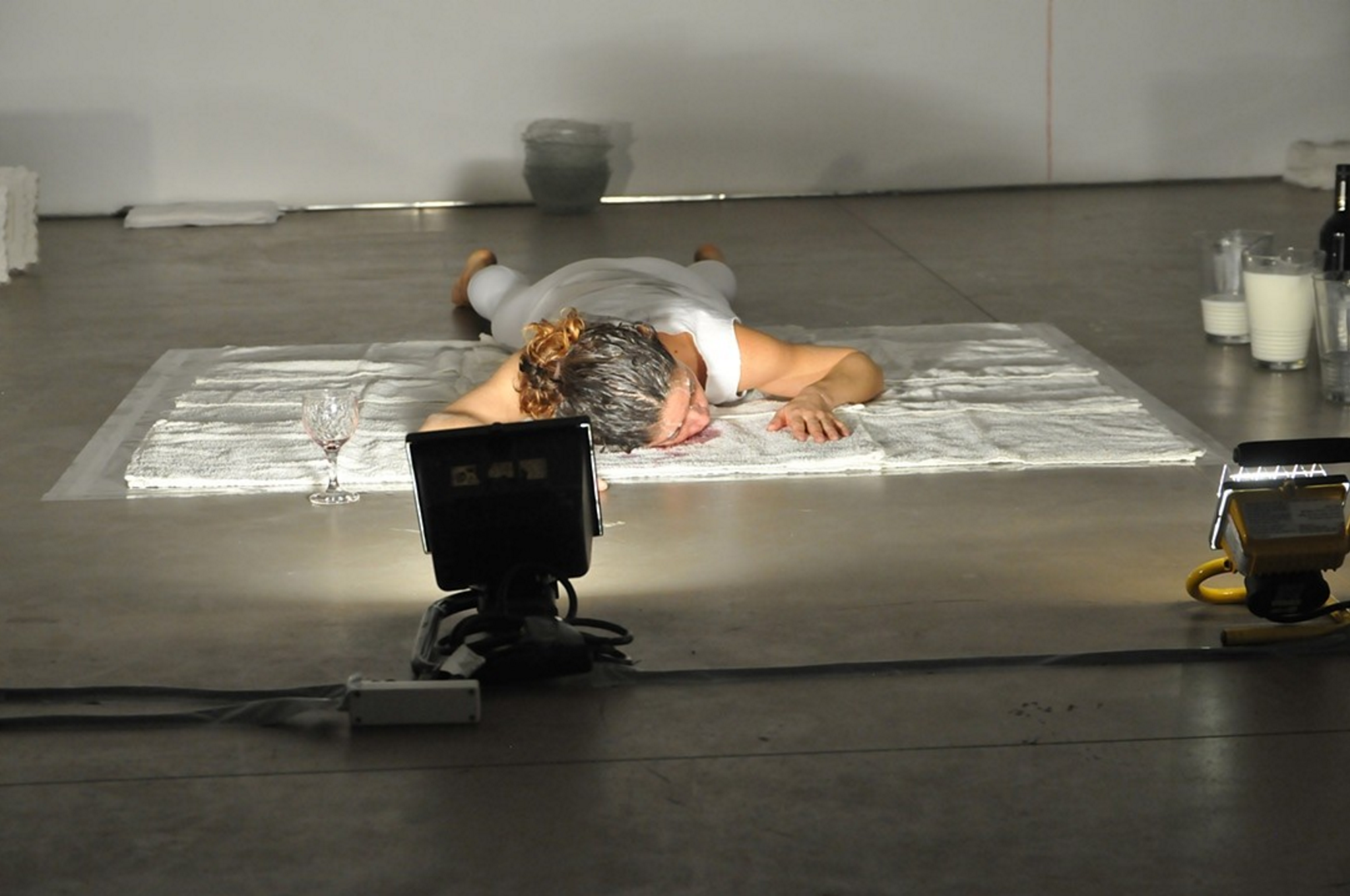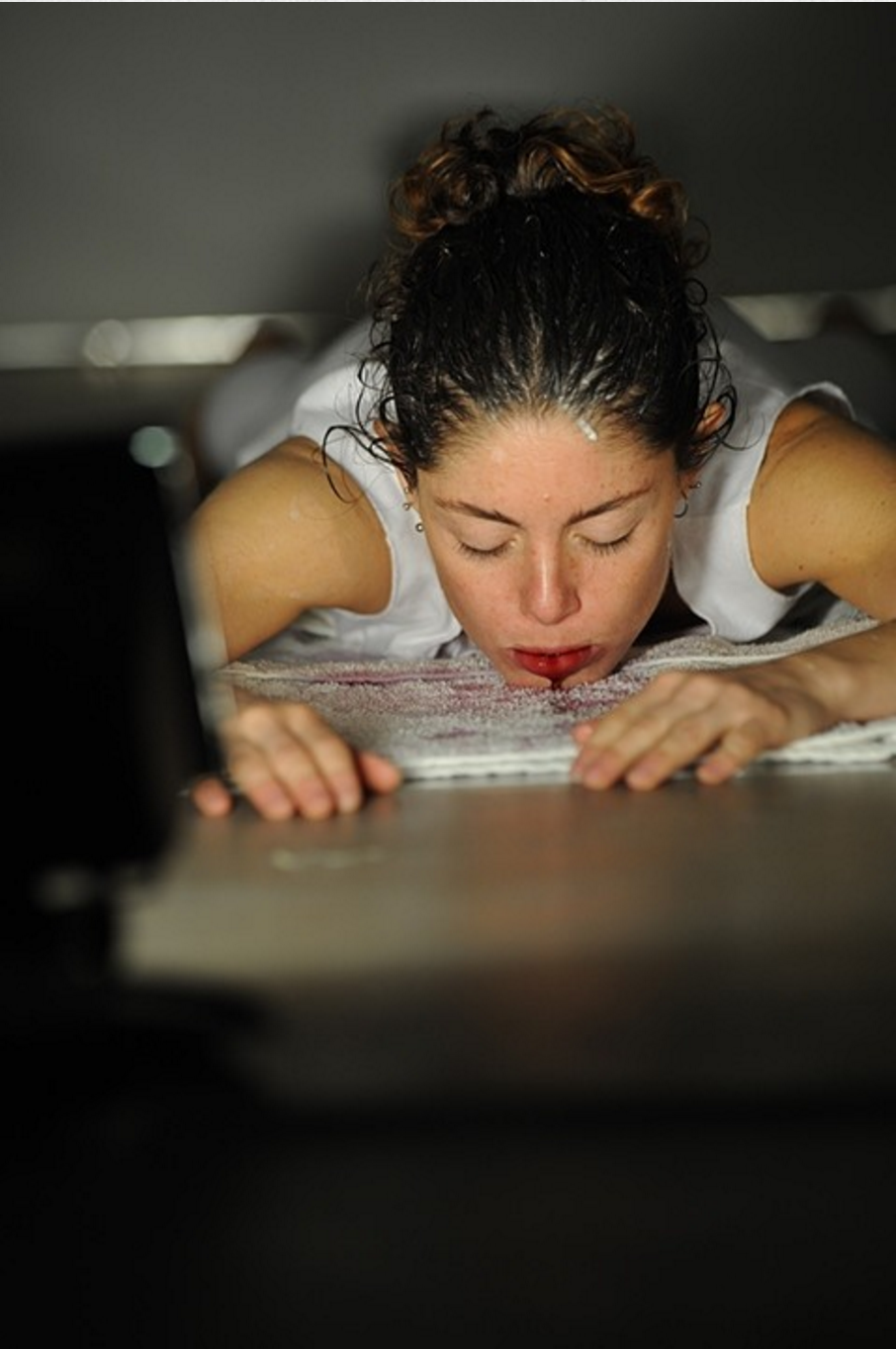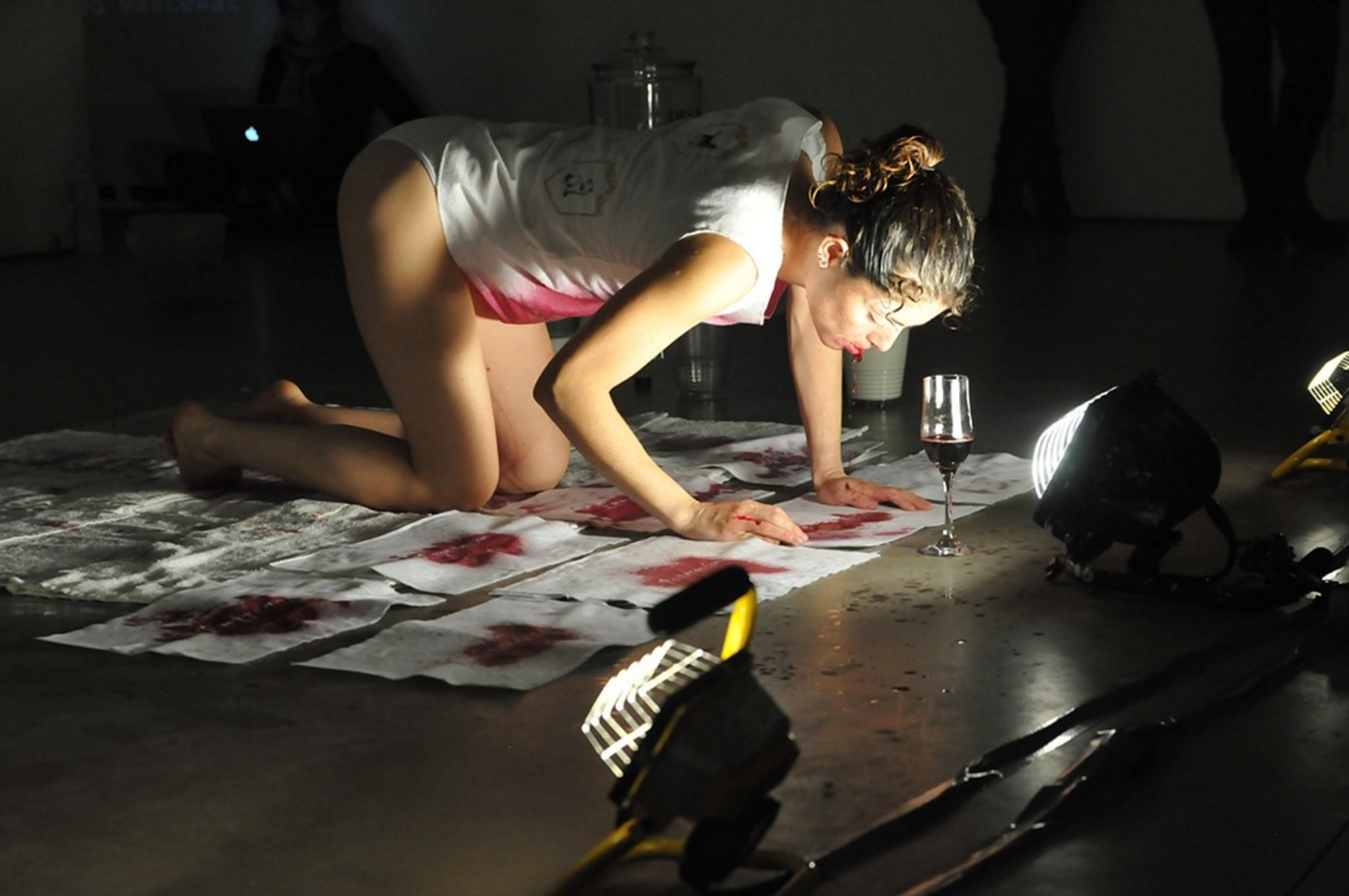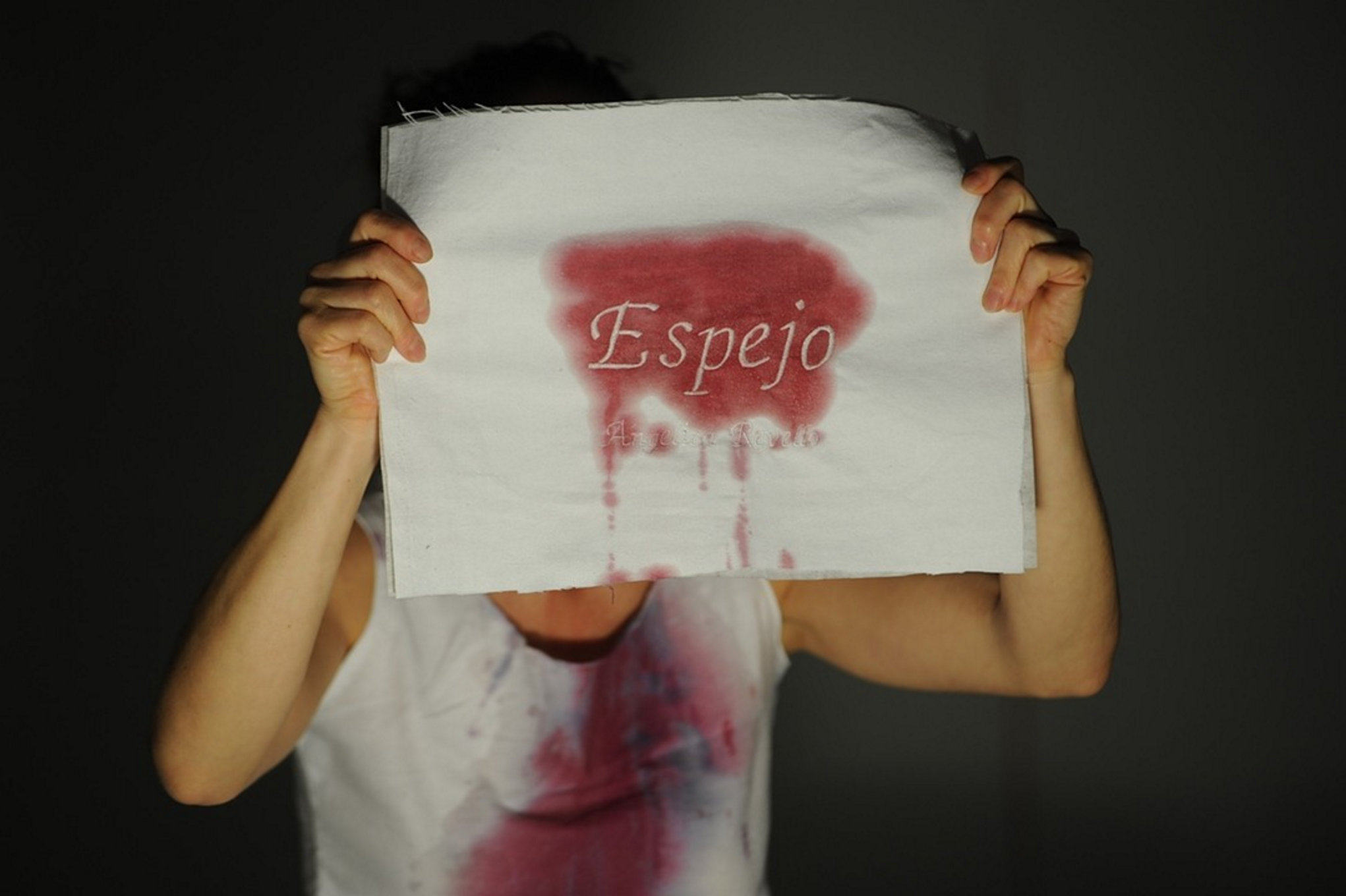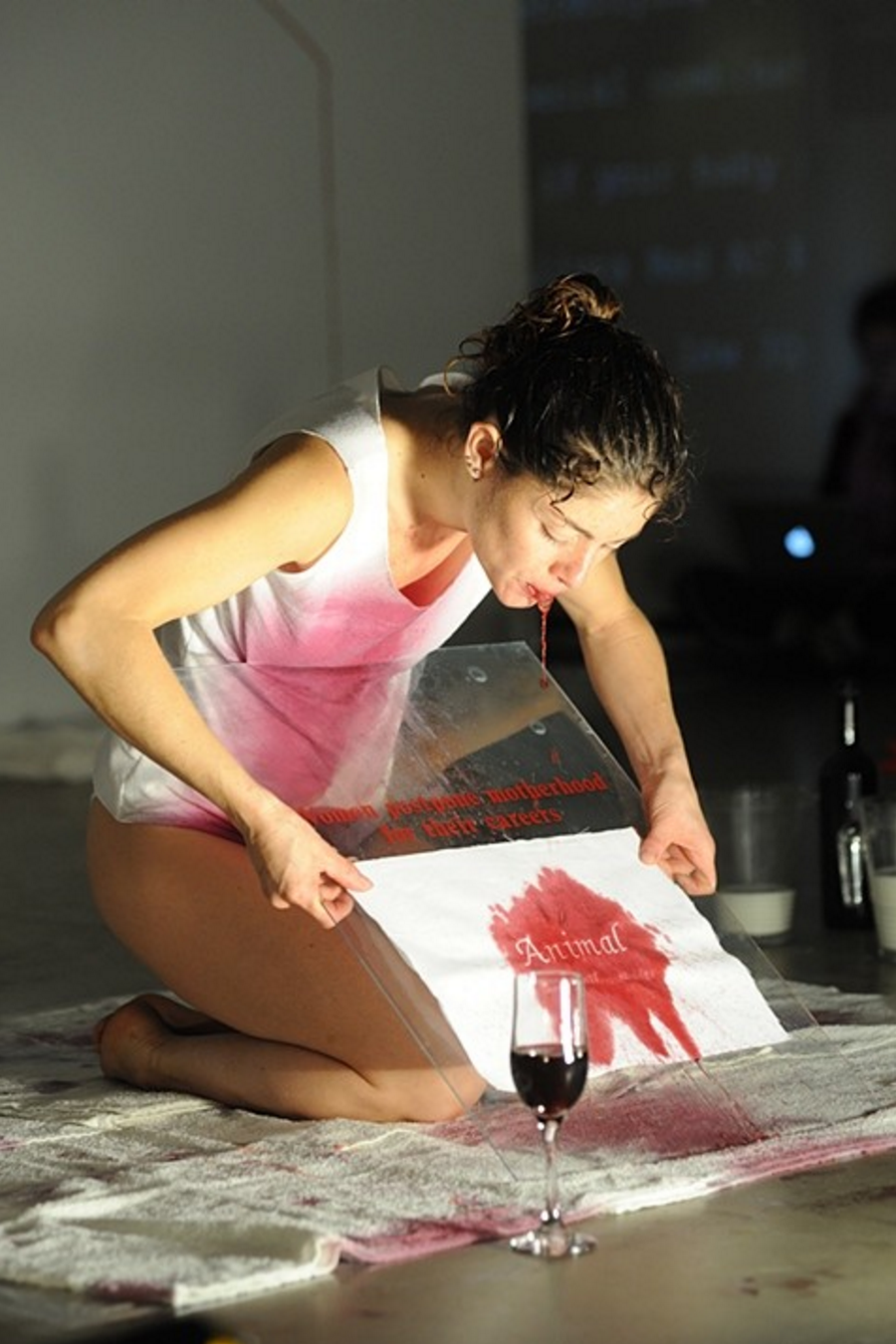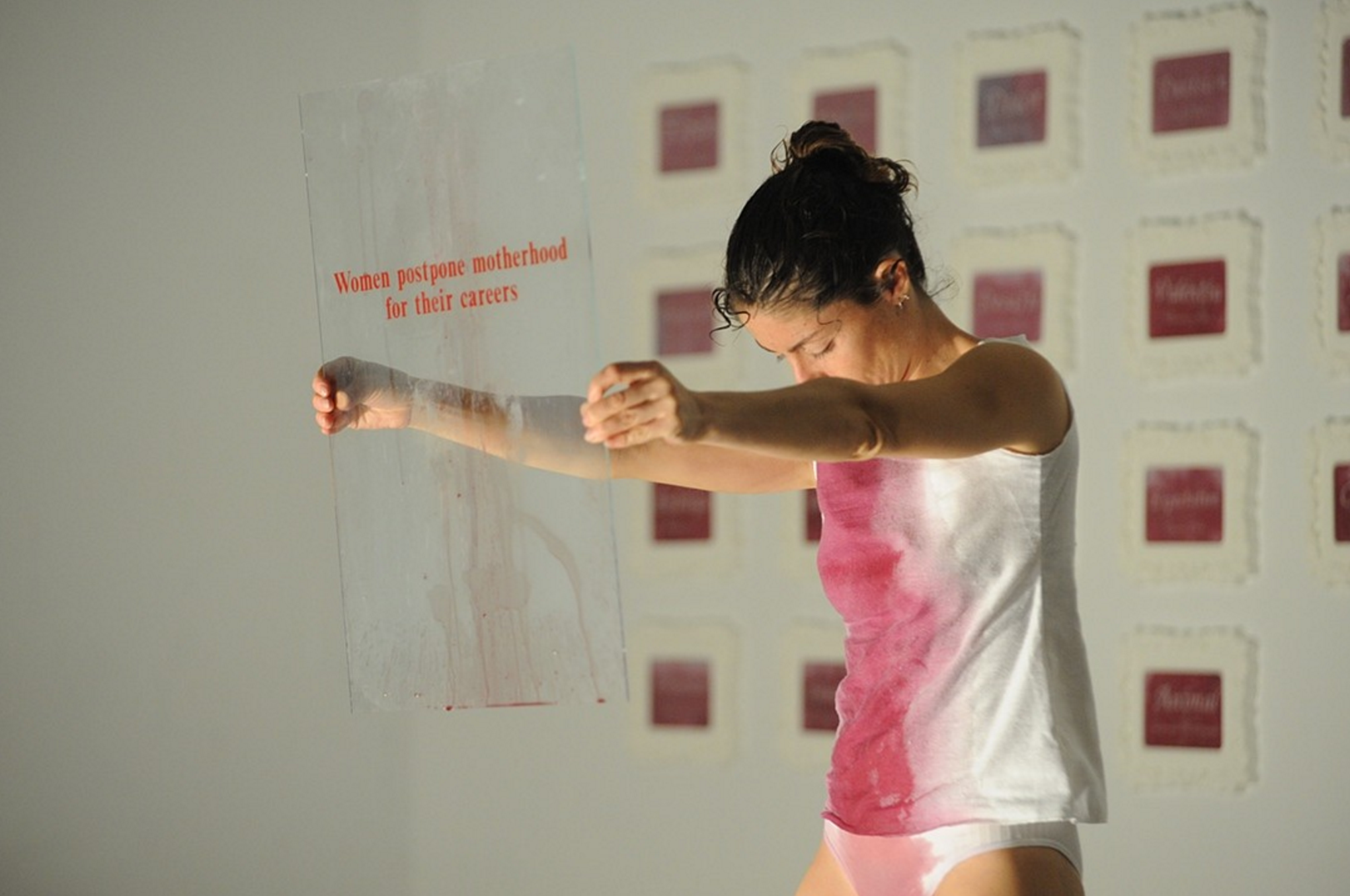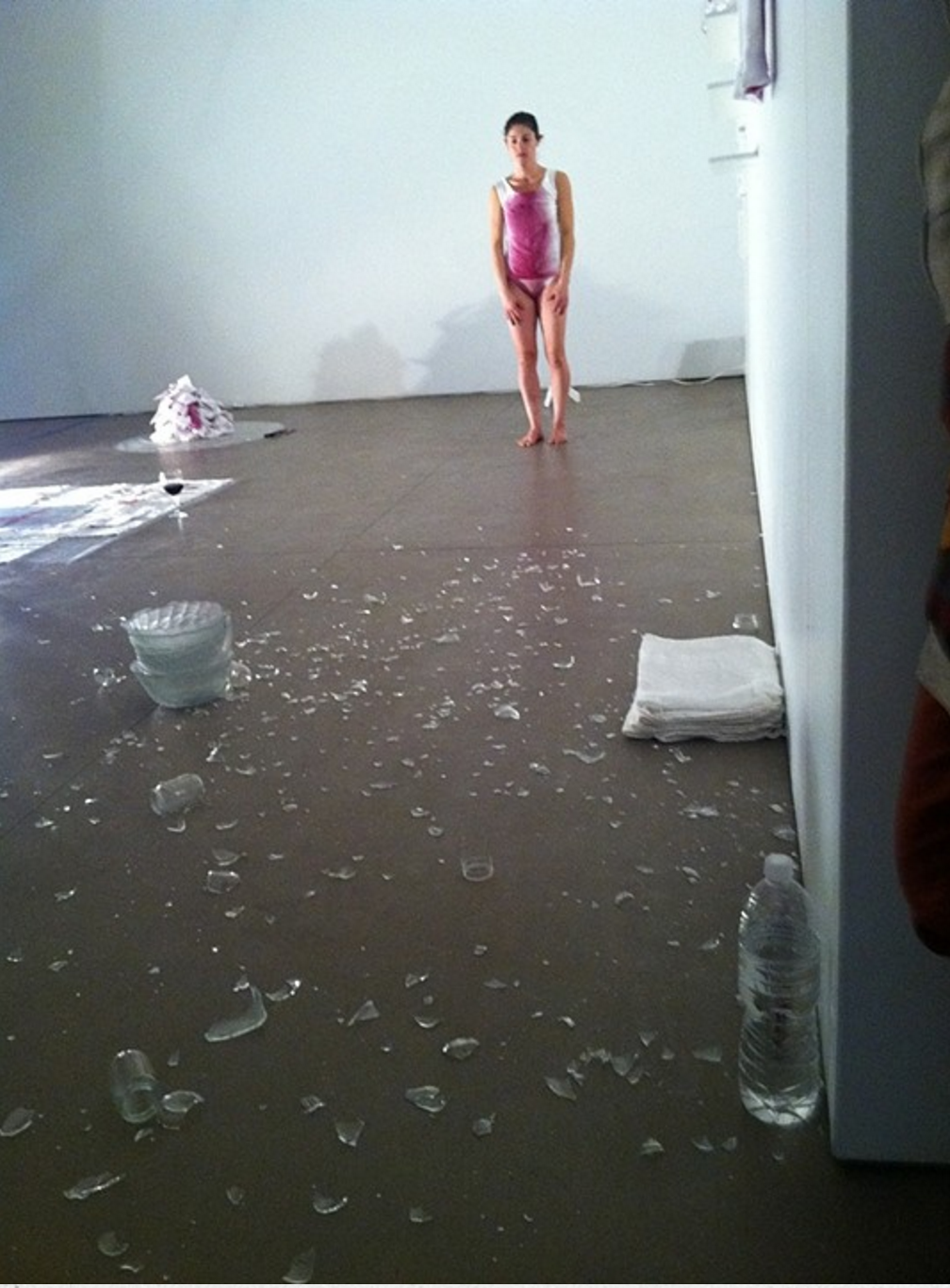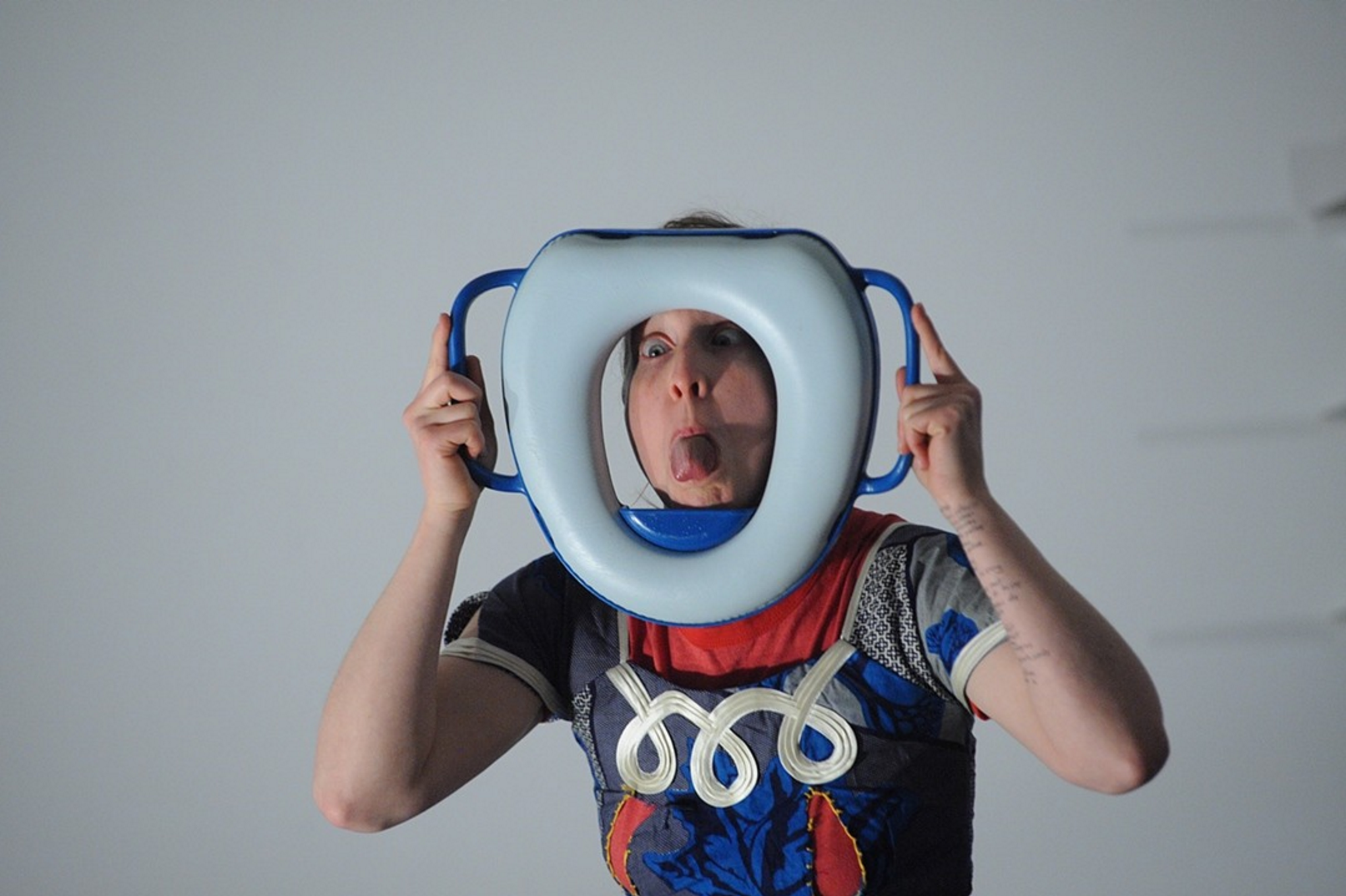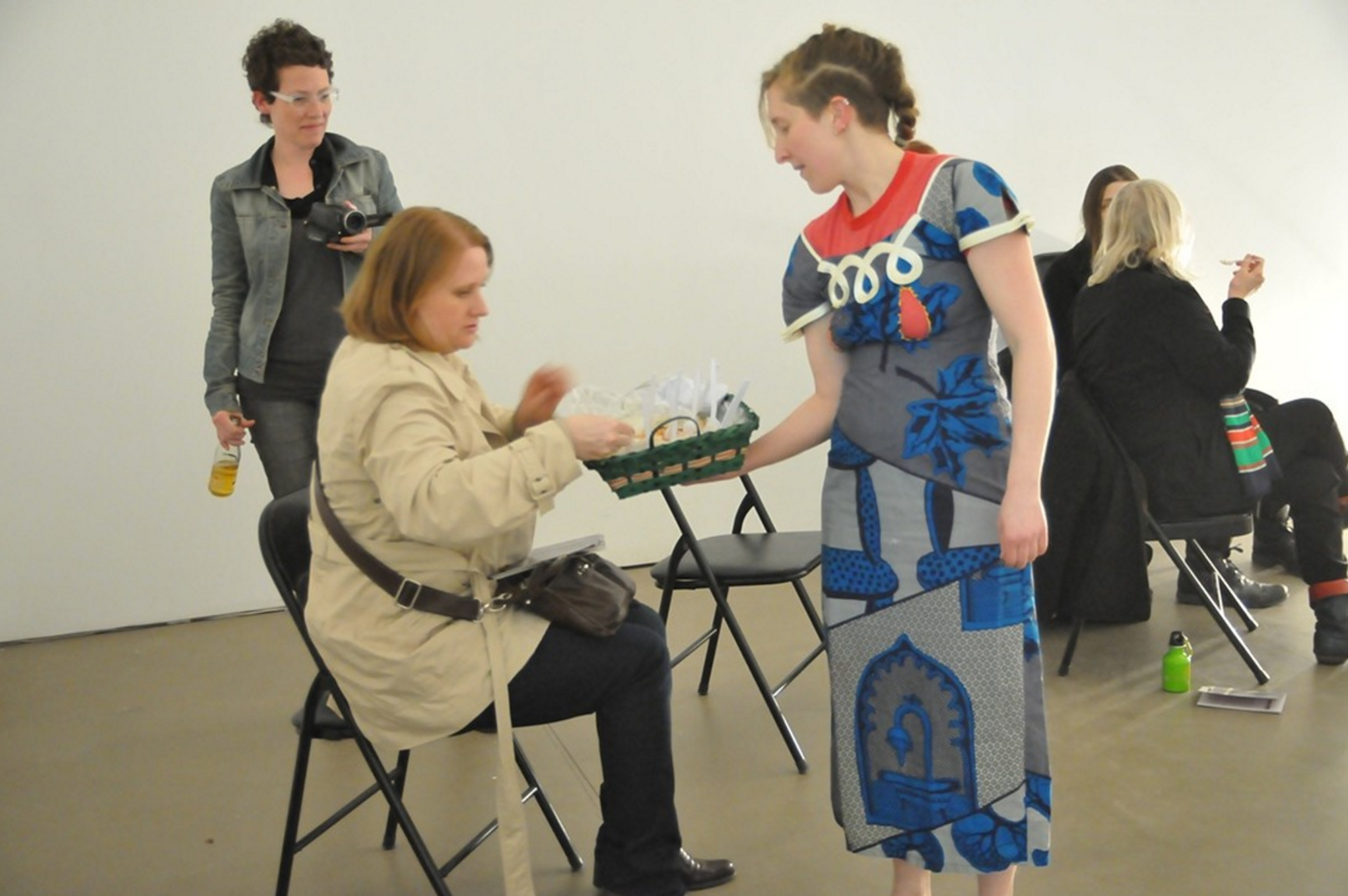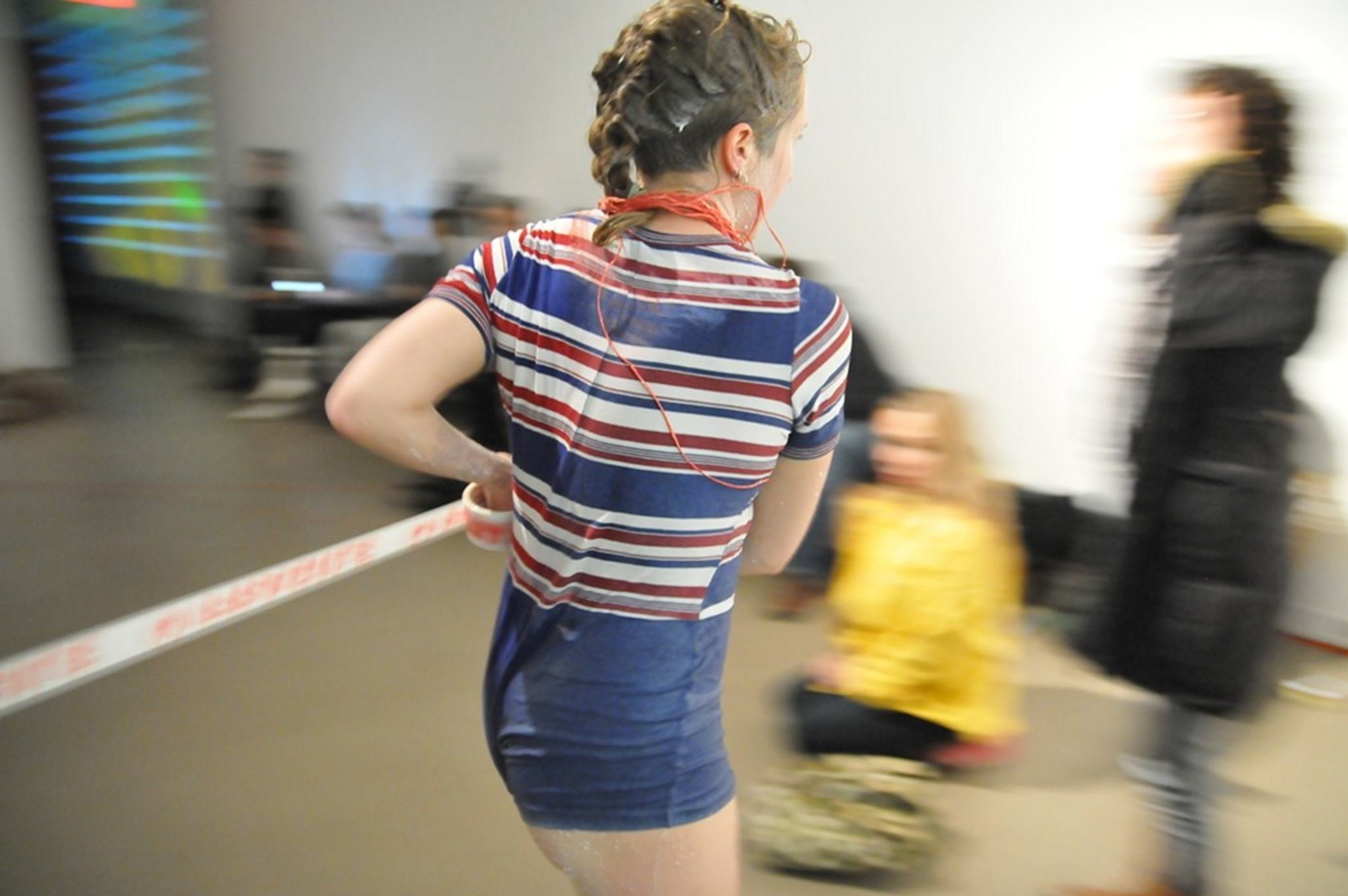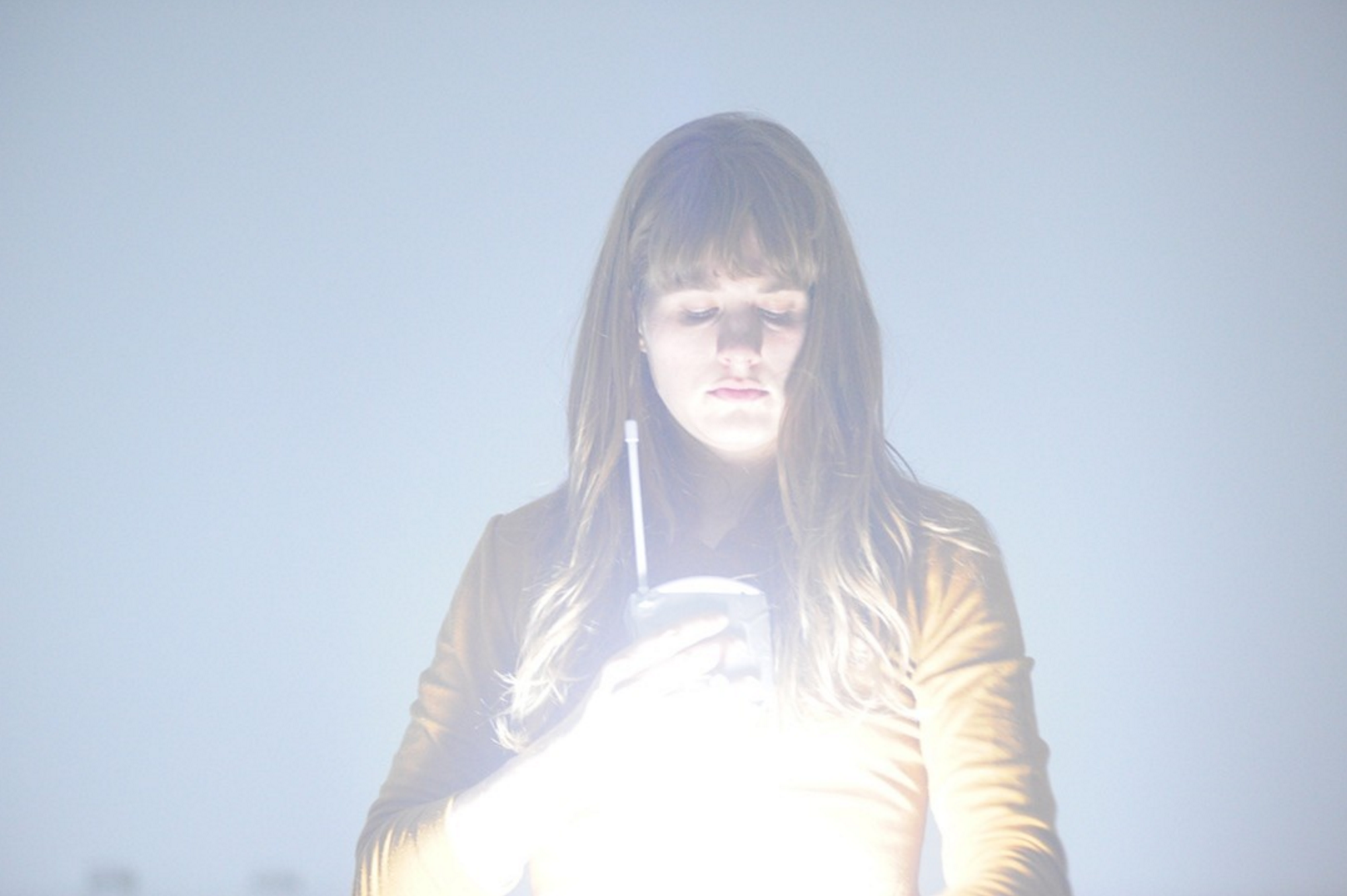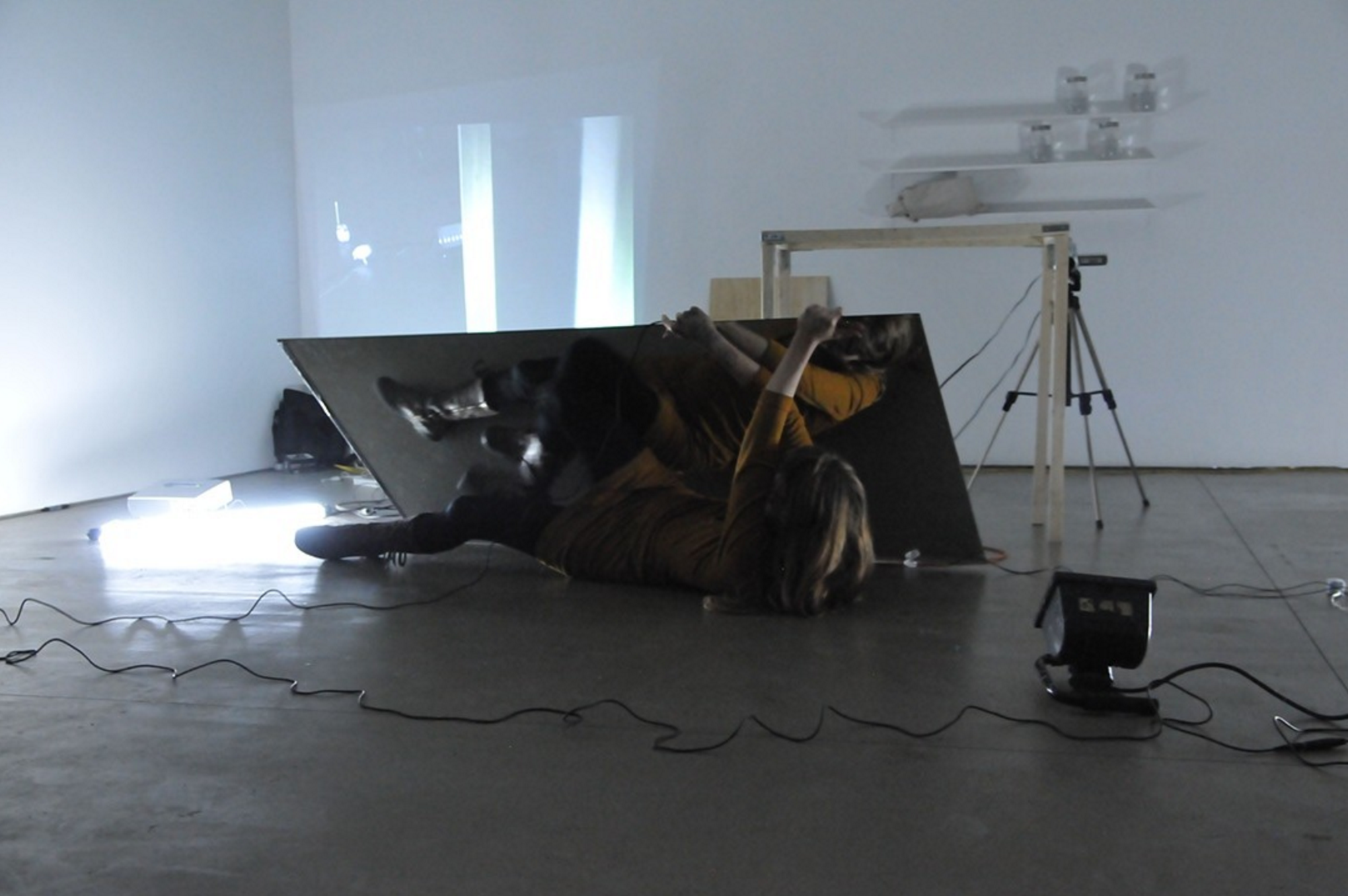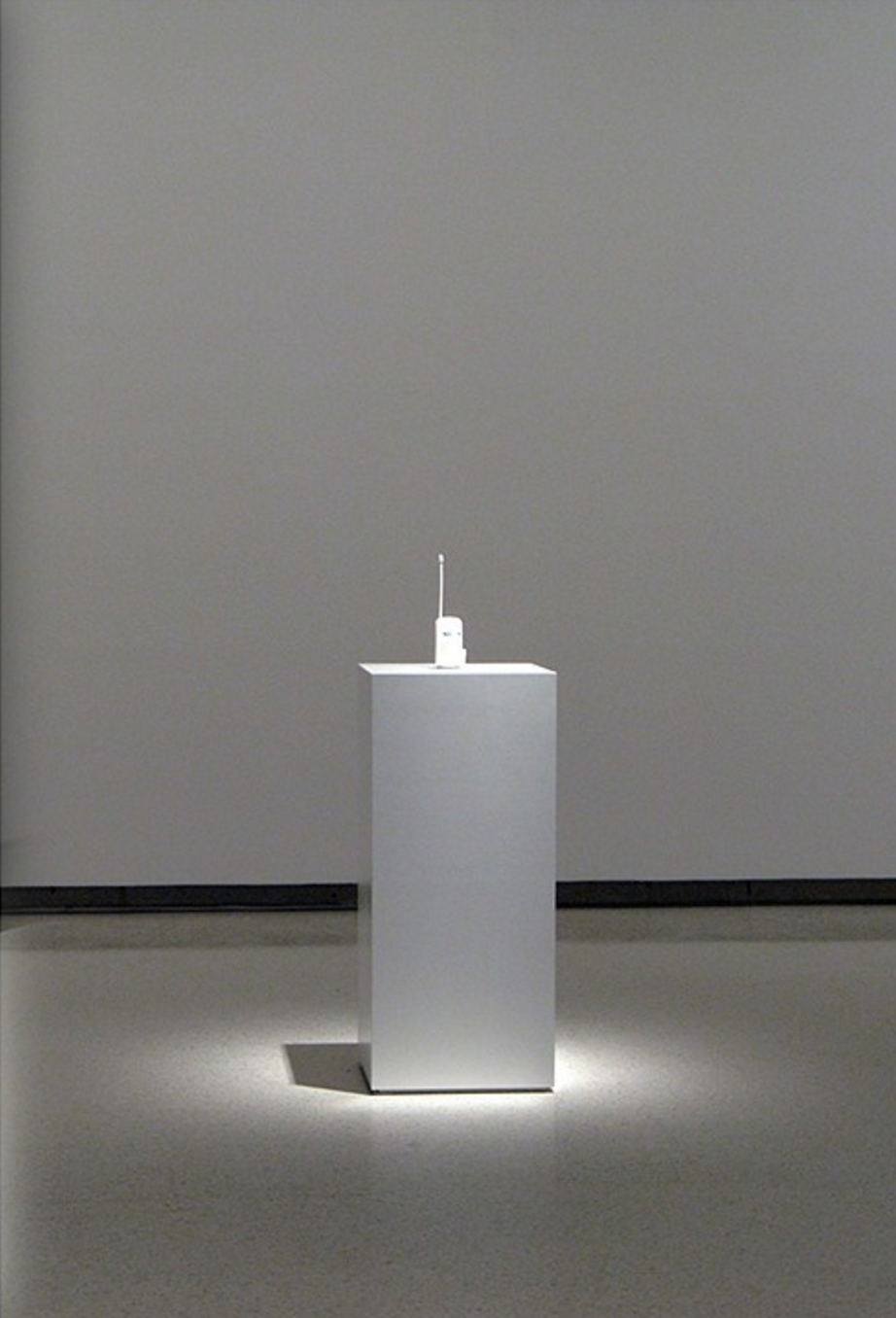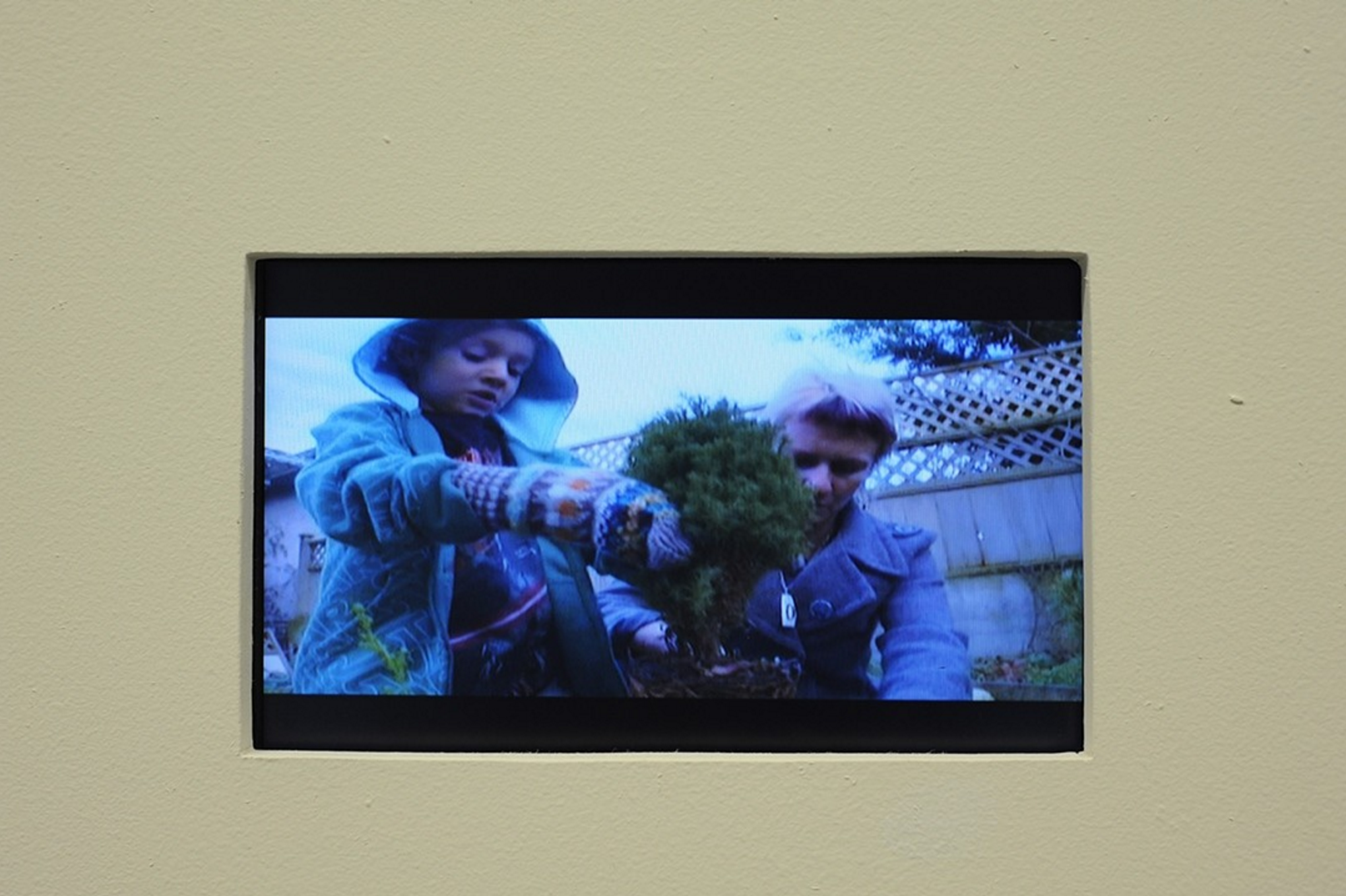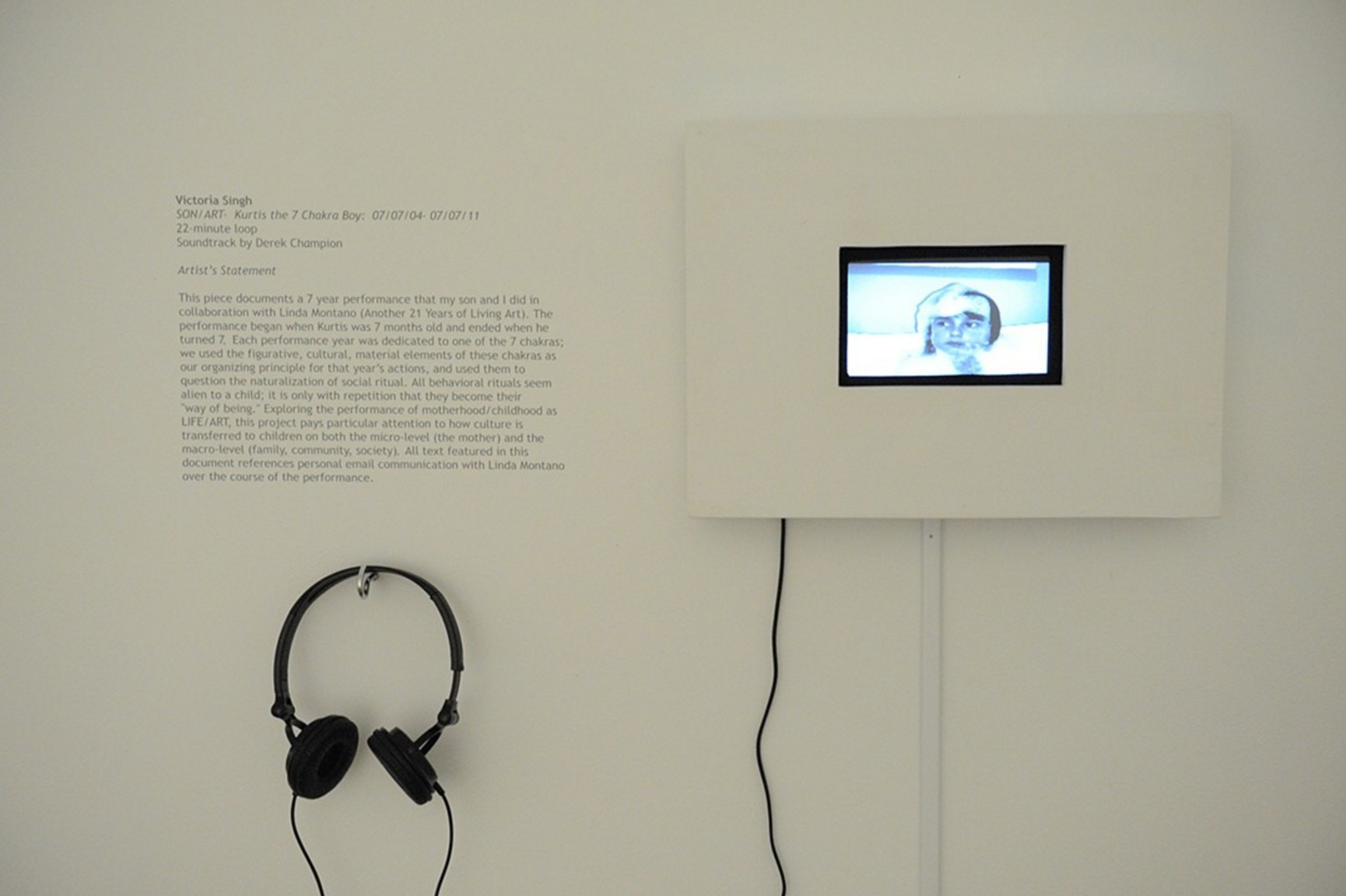Event Photos by Henry Chan & Video Stills courtesy of individual artists
Jill Miller: The Milk Truck
“Outfitted with a giant boob and flashing emergency-light nipple, this truck makes public breastfeeding a collective care issue. In an ongoing social practice performance, Miller places The Milk Truck on-call for mothers subjected to uncomfortable public reactions while breastfeeding. Here’s how it works: whenever a mother is harassed or hassled for nursing in public, she can call, text, or email the truck and have it spring into action. The crew of The Milk Truck arrive to host a spontaneous breastfeeding party at the site of the offending establishment, raising awareness of the continued coding of the breast as sexual but not functional in public space.”
— from the New Maternalisms catalogue
Alejandra Herrera: Challenge
3 hour durational performance
“Working with milk and wine, wielding broom and dustpan, and stationed among 60-odd empty baby food jars and a dozen old salad bowls, Herrera Silva undertakes a three-hour performance that cycles through materials, moving them, arranging them, breaking them and cleaning them up again. By invoking the materiality and distributed attention of domestic labour, Herrera Silva does not so much represent domestic and maternal labour practices as implicate her viewer-participants in their unfolding. At once trapped in and dedicated to these maternal practices, Herrera Silva draws attention to the question of sustainability in our maternal desires to nurture, love, and care. The Challenge here, then, is how to take the social and biological drive to nurture and nest seriously without reducing its complexity, simplifying its expression, or coding which bodies can do what and how.”
— from the New Maternalisms catalogue
Lovisa Johansson: The Milky Way
3 hour durational performance
“In this three-hour durational performance, Johansson recalls her experience of the time-space and care-filled attention of the early maternal relation. Working with a ring of hourglass-shaped baby-bottles, The Milky Way invites us to join the artist in inhabiting the syncopated rhythm and subtle detail of milk dripping from nipples in space.”
— from the New Maternalisms catalogue
Hélène Matte: L’Essence de la Vie
performance action, 45 minutes
“Hélène Matte’s text and action-based performance, L’Essence de la Vie, urges us to inhabit a space between the densely local maternal body and the social narratives that structure our relations to it. The only performer to use speech as one of her central materials, Matte works with language, humour, and visual puns, asking us to consider mothers as cultural-workers, social structures, and poetic images that knot together new life and inevitable death.”
— from the New Maternalisms catalogue
Marlène Renaud-B: Dis/sociation
performance action, 40 minutes
“Marlène Renaud-B’s action-based performance Dis/sociation works at the intersection of representation and material enmeshment, using a night-vision camera, a mirror, and a baby monitor to explore the limits of sight and sound as access points to the maternal body. Playing with distortion, reverberation, and mediated or doubled images of her body, Renaud-B reminds us that representation—a structure organized by identification and objectification, subject and object—is no longer sufficient for understanding maternal art practices. Instead, her tripartite performance draws us into an ambivalent negotiation of the materialities of body, affect, and image.”
— from the New Maternalisms catalogue
Lovisa Johansson: Jumping Lullaby
performance action, 30 minutes
“Johansson works with a large tray of alarm clocks that are constantly going off. Jumping to soothe them and wrapping them in swaddling cloth, her action becomes more and more frenetic and exhausting in what might look like an exaggerated play on night-wakings but that, for those who have experienced extreme sleep deprivation, hits the nail all too closely on the head. Nothing compares to the desperation and powerlessness of holding your baby close as they wail inconsolably for the umpteenth hour. Everything in you is driven to soothe them, but nothing works; everything urges you to care, but the caring is torture.”
— from the New Maternalisms catalogue
Lenka Clayton: Maternity Leave
Skype-based Durational Performance
On the 23rd April 2011 Lenka Clayton gave birth to Otto in Pittsburgh, America.
For the first year of Otto’s life Clayton is on maternity leave.
Maternity Leave is a durational performance that takes place in the artist's home and is transmitted via live-streamed audio to the artist’s traditional place of representation; the gallery. A white plastic baby monitor on a plinth emits the cries, babble, and distant domestic audio world of the newborn's room. The host institution pays the artist the equivalent of the “Maternity Allowance”, the government subsidy she is eligible for in her home country, England.
Mark Cooley & Beth Hall: Safe
Artist’s Statement:
The popular imagination is heavily invested in a romanticized conception of the maternal. The laborious, messy and complex beauty of living with children is lost in countless sanitized and idealized images of a superficial, strictly gendered, privatized and heavily branded maternity. Popular culture gives a pre-packaged answer to the complex questions of parenting in a quickly changing world. For some, parenting is narrowed to a list of milestone purchases – graduating kids through a series of child development books, baby seats, bicycles, cell-phones, computers, cars, and so on into adulthood. Those who prefer a critical and active approach to parenting soon discover that information and disinformation abounds, and critically engaged parenting can quickly lead to significant research skills. Though the labor of caring for children is generally maligned in popular culture, if given attention, the daily rituals of child care-giving reveal a beauty based on a system of values radically different to those conjured by the media’s constant appeals to our well cultivated sense of alienation, self-interest and fear.
Gina Miller: Family Tissues
6-minute loop
Artist’s Statement:
Family Tissues details the performance of unwrapping my frozen placentas and creating conversation and action around them with my three sons. Family Tissues refers to a theoretical and experiential exchange regarding growth, both in biological and philosophic terms. The placentas become a site for conversation about relationships and ecologies in the micro and macro. The placenta digests all dead organisms while providing the very nutrients essential for life. It is essential for biological development, and also stands as a symbol for the ongoing symbiotic relationship I have with my boys. The visceral materiality and function of the placenta speaks to the ways that we are in a constant state of being-in-process with each other and the environments that, literally, make us.
Dillon Paul & Lindsey Wolkowicz: In Place
168-minute loop document of a week-long art/life performance
Artist’s Statement:
Being a parent is a constant balance between the creation of structures and the hope to be openly, fluidly present. At the core of these seemingly polar desires is time; time for sleep of both parent and child, the distance between eating, between bowel movements, time when childcare is needed, the amount of time spent at work, the amount of time left in the day afterward to spend with your child, the need to find energy in whatever time presents itself, the time needed to have a romantic relationship, friendships, for self care, for self actualization, and the time needed to show support for your child’s own self-actualization. These units of time become puzzle pieces moved around within the course of a day, a week, a year and the need for them to fit together into a cohesive, stable, safe construction that somehow lets air pass through it freely, feels like one of the most constant and necessary challenges of life with a child. In Place is a time-lapsed document that collapses a 168-hour performance into 168 minutes detailing the shifting puzzle pieces of the artists’ family from the overhead perspective of the parents’ bed.
Victoria Singh: SON/ART
— Kurtis the 7 Chakra Boy: 07/07/04 — 07/07/11
22-minute loop
Soundtrack by Derek Champion
Artist’s Statement:
This piece documents a 7 year performance that my son and I did in collaboration with Linda Montano (Another 21 Years of Living Art). The performance began when Kurtis was 7 months old and ended when he turned 7. Each performance year was dedicated to one of the 7 chakras; we used the figurative, cultural, material elements of these chakras as our organizing principle for that year’s actions. Exploring the performance of motherhood/childhood as LIFE/ART, this project pays particular attention to how culture is transferred to children on both the micro-level (the mother) and the macro-level (family, community, society). All text featured in this document references personal email communication with Linda Montano over the course of the performance.
Alice De Visscher: Dream or Nightmare of Motherhood
4-minute loop
Artist’s Statement:
Not yet mother.
Two actions, both filmed in the same corner of my kitchen:
1. My stomach inflates a balloon until it breaks.
2. Two washcloths on my breasts; milk is flowing from them.
Something similar could happen one day to my body.
(In French, we say “to have breasts like washcloths”/ “avoir des seins comme des gants de toilette.”)
These actions are from my dreams, my fantasy.
I don’t know exactly what they mean.
They mean what you see in them.
I’m not yet a mother. I don’t know what to be a mother means.
I dream to be one and I fear to be one.
Masha Godovannaya: Hunger
39-minute loop
Artist’s Statement:
As if in response to Adrienne Rich’s contention that “[motherhood is] the suffering of ambivalence: the murderous alternation between bitter resentment and raw edged nerves, and blissful gratification and tenderness,” in Hunger I explore the conflicts of motherhood and creativity, domesticity and self-reflection. Three screens are placed near each other in a row. The uninterrupted process of breastfeeding captured on one of them defines the duration of the work while the other two screens intertwine with each other, to present several repeating narratives/conflicts, their possible developments/resolutions, and the ambivalence of the maternal experience and affect. But this document of the multiple performances of my everyday life doesn’t illustrate these concepts directly; the concepts develop and change through the creation of this record of labor, struggle, and maternal enmeshment.



